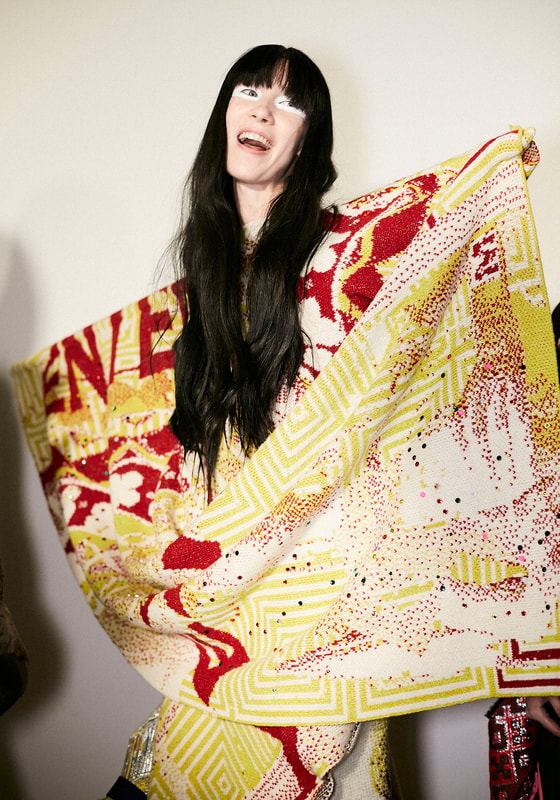|
22/9/2020 The evolution of London Fashion WeekHow the youngest and most experimental of the major fashion weeks came to be The Early DaysWhile it is now firmly cemented as one of the four major fashion capitals of the world, London’s place as a global fashion power player is a fairly new phenomenon. A hub of creativity and style innovation since the 1960s thanks to models like Twiggy and designers such as Mary Quant, Barbara Hulanicki and Ossie Clark, the early London shows grew out of this spirit of freedom and, as such, London Fashion Week is still seen as the boldest and most unrestrained of the four major fashion weeks.
And, with its home just moments away from Kensington Palace, it wasn’t long before royalty was embracing the city’s growing fashion scene. Despite much of the clothing being heavily influenced by London’s rave scene and subversive youth subcultures, Princess Diana threw open the doors of Lancaster House to host a reception for British designers in 1985 and was often seen sporting their wares. a tough time in the 1990sBut, after a successful start, the 1990s were to prove a little more difficult for London’s burgeoning design scene. The excess of the 80s gave way to a recession in the 90s and, with waning interest and less money to invest in shows, by 1992 London Fashion Week was reduced to just a small handful of designers showing at The Ritz. However, seeing the path the industry was headed down, the BFC came to the aid of young designers by establishing its still popular NEWGEN scheme, which supports young designers with both financial aid and mentorship to help get their businesses off the ground. And, although they weren’t NEWGEN recipients, the decade was also a stellar one for emerging talent. Alexander McQueen staged his first show in 1992 and, in 1995, Stella McCartney would follow with her famous graduate collection featuring Kate Moss, Naomi Campbell and Yasmin Le Bon. Although both these brands would eventually defect to New York and Paris, they were quickly followed by big British names such as Matthew Williamson and John Rocha. fashion week enters the digital ageWith a new home at the Natural History Museum, where it was held from 1994 until 2009, London Fashion Week flourished during the 2000s. A new generation of daring, experimental and highly covetable designers emerged and names such as Hussein Chalayan, Christopher Kane, Mary Katrantzou, Erdem Moralioglu and Roksanda Ilincic made London Fashion Week the freshest and most exciting in the calendar. In 2005 Topshop also became the first high street store to join the official schedule. 2009, the year the shows moved to a grand location at Somerset House, proved to be a particularly special year. Heritage British brand Burberry signalled its approval by returning to the London schedule from Milan while brands including Paul Smith, Matthew Williamson and Luella also rejoined. The growing influence of the internet also saw the rise of London Fashion Week street style and the live streaming of shows (LFW was the first to offer this in 2012) to an avid digital audience, growing the reach of the both London Fashion Week and its exhibiting designers internationally. In the last decade, despite ongoing conversations about the viability and sensibility of the traditional fashion system in the age of the internet and fast fashion, London Fashion Week has gone from strength to strength, brining in around 5,000 press and buyers each season. After a short stint at Soho’s Brewer Street car park, the shows found a new home at The Store Studios (just down the road from Somerset House), from which new names such as Molly Goddard and Matty Bovan have emerged. london fashion week expandsIn fact, so successful was London Fashion Week in the late Noughties that, in 2012, London Collections: Men (later renamed to London Fashion Week Men’s) was formed. Taking place in January and June to coincide with the other major international menswear shows, it has grown to include nearly 80 designers. In 2016 the BFC also expanded London Fashion Weekend, a consumer-based event which opened the London Fashion Week format to the public and had been taking place since 2008, to become the London Fashion Week Festival. Taking place over ten days, the festival offers designers the chance to meet their customers through talks, workshops, shopping experiences, catwalks and digital events, with more than 150 brands taking part. Of course, when the coronavirus pandemic struck in spring 2020, like all fashion weeks, London was forced to go online. Taking place in June, during the height of lockdown, London Fashion Week Men’s was the first to experiment with this new format, offering both industry professionals and the public access to a Netflix-style platform hosting video presentations, talks, podcasts and written content. It was roundly considered a success and, when it came to London Fashion Week in September, a hybrid schedule of physical and digital events was announced, with most designers opting for small group appointments instead of traditional runway shows. London, like all the major fashion weeks, undoubtedly faces challenges ahead as the world grapples with the ongoing Covid-19 pandemic. However, if the innovation, creativity and appetite for change it has exhibited over the last four decades is anything to go by, London Fashion Week will remain one of the industry’s key events for years to come. Comments are closed.
|
Search by typing & pressing enter






